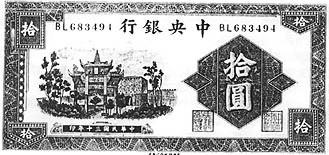The printing of banknotes during the War of Resistance against Japanese Aggression, except for the Nationalist Government’s continued use at the time; the legal currency; (ie the banknotes issued by the Central Bank, the Bank of China, the Bank of Communications, and the China Farmers Bank) Currency; and; banknotes;; Japan and the United States in its occupation of the occupied area of ​​China also issued some counterfeit notes.
1. Banknote printing in the control area of ​​the National Government
In the early days of the War of Resistance Against Japanese Aggression, the Japanese were rampaging offensively. More than half of China had fallen into one after another, and the Kuomintang-led Nationalist Government had gradually retreated to the southwest-dominated rear. Because the printing department of the Beijing Ministry of Finance, which was engaged in printing money at that time, broke into the rivals, the banknotes issued by the four major banks of the Nationalist Government were mainly printed on behalf of the United States, Britain, and other countries. In the war years, however, the traffic was inconvenient. At that time, Kong Xiangxi, the Minister of Finance of the National Government, approved the establishment of a banknote printing office at the Central Trust Bureau to allow him to design a set of banknotes that could be produced in the air-raid shelter and prepare to establish a banknote printing plant in Chongqing. . In 1941, on the basis of the Printing Department of the Chongqing Ministry of Finance, it was reorganized into a Chongqing Banknote Printing Plant.
In the same year, it also purchased three plants of the Beijing Press in Chongqing. At this time, the Chongqing Banknote Printing Plant has reached a scale of 40 hand-puckered gravure presses, a four-opening platform press, and 25 electric gravure presses. Since then, the plant has continued to expand, and in August 1944, eight people were sent to the United States to study techniques such as engraving, printing, electroplating, photography, offset printing, and gravure printing. Later, they ordered 50 units of gravure printing machines, embossing machines, and cutting machines from the United States. In 1945, the Central Government of the Nationalist Government decided to acquire the Chongqing Printing Factory and build a central printing plant on this basis. At this point, the Central Printing Plant has become a large-scale, comprehensive printing plant with more than 100 printing equipment, with more than 2,400 employees, large scale, advanced technology, and the ability to print various kinds of printed matters including banknotes. .
The Central Printing Plant is a large-scale integrated printing institution under the control of the National Government and mainly printing money. Its predecessor was the Central Trust Bureau and more than ten small electric motors, which insisted on production in the air defense tunnels. The bombing of the plane outside the cave and the roaring of the machine inside the cave are very difficult. It is under such difficult conditions that the factory produced the first banknote after the establishment of the factory (1941).

Figure 17-26 The first note printed by Chongqing Printing Factory
On March 1st, 1945, the Printing Department of the Central Trust Bureau was ordered to reorganize as a central printing plant, and began to expand the factory on the slope below the original site of the Chongqing Printing Plant. The first and second printing houses of the former Chongqing Printing Factory will be built. Three workshops were relocated and production was centralized. The initial English name was Cinina Printing & Engraving Works, later changed to Cnina Engraving & Printing Works. Figure 17-0 shows Wuyiyuan banknotes printed by the central printing factory in the 34th year of the Republic of China (1945).
On the eve of the victory of the War of Resistance Against Japan, the Chongqing Plant of the Central Printing Plant had ordered the preparation of a post-war demobilization plan, and entrusted the Wartime Production Bureau of the Ministry of Economic Affairs to order printing equipment from the United States. After the victory of the Anti-Japanese War, the plant was closed, and equipment and equipment were shipped to the Shanghai Plant of the Central Printing Plant.
In addition to the printing plant in Chongqing, the central printing plant also has a central printing plant, Chongqing Paper Mill, Shanghai Plant, Peiping Factory, Mie Factory, and Wanhua Plant. Among them: Chongqing Paper Mill is a paper mill that produces securities paper as its main business. Its predecessor was the Central Bank, which took over the Longzhang Paper Company; the Central Paper Mill. After the Central Printing Plant took over the Central Paper Mill in 1947, it was renamed as Chongqing Paper Mill.
The Shanghai factory was established in September 1945 and was reorganized from the former Shanghai Puppet Central Reserve Bank Printing Office. The plant is based on Columbia Road Plant as its main plant, and it also has Houjia House Factory, Qiqihar Road Plant, Xujiahui Plant and Laojizi Road Ink Factory. In early 1946, equipment and equipment of the Chongqing factory were relocated to the factory. At the end of 1946, the plant was used; the Chinese and American lending bills; the various types of new printing presses purchased from the United States were installed; together with the closing of the Chongqing plant, the Peking factory was tightened, resulting in the plant becoming the main factory of the Central Printing Bank's printing vouchers. .

Figure 17-0 Wolverine Banknotes Printed by the Central Printing Factory
The Beiping Plant received the original pseudo-North China Finance Committee Printing Bureau (formerly the Printing Department of the Ministry of Finance, and the present Beijing Banknote Printing Factory) after the war and officially commenced production in February 1946. However, due to the tightening of the Beiping Plant at this time, the number of personnel had been reduced from 4,000 to 1,200. The scale of production has been greatly reduced.
The Mie plant was established in 1949 and was originally established in Jintongli, a triple-rooted township in Taiwan; the Taipei factory. The equipment for the initial period of construction was shipped from the Shanghai plant, including 17 large motors, four full-face printing machines, eight embossing printing machines, four embossing printing machines, and plain printing. Full-scale Hailisi Machine 2, Japanese-style printing, Nakajima Machine 2, electroplating equipment, and equipment for ink and ink transfer. In 1954, the Central Printing Plant's General Administration Office merged with the Taipei Plant, collectively known as the Central Printing Plant; the Taipei Factory was renamed the Triple Plant.
Wanhua Plant, originally a Dali Street factory printing banknotes printed at the Bank of Taiwan, is located at 42nd Lane, Dali Street, Taipei City. The factory was founded in 1946 and started production in 1947. It was taken over by the factory in early 1961. At the beginning of the takeover, there were eight large motors, one typographer, and more than ten stamping machines. Afterwards, due to production requirements, it also allocated seven large motors, four millers, and a platform-type printing machine from the three-factory plant. The plant's production capacity has also been improved.
The White Cardboard Bag is always made from white card, coated paper etc. They are one of the most high-end packaging material which are used in packing all kinds of clothes, bags, cosmetics, and gifts etc. The white cardboard bag can be printed with colors inside and outside to make them more beautiful and high-end but with low cost, which makes them affordable and widely used.

White Cardboard Bag
White Cardboard Bag,Ivory Cardboard Bag,White Paper Bags,White Cardboard Paper Shopping Bag
Shenzhen Hongte Printing & Packaging Co., Ltd. , http://www.ipackpaperbox.com